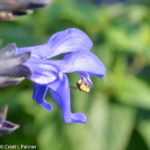 The US Environmental Protection Agency (EPA) released proposed interim registration review decisions for neonicotinoid insecticides (Federal Register Feb 3, 2020).
The US Environmental Protection Agency (EPA) released proposed interim registration review decisions for neonicotinoid insecticides (Federal Register Feb 3, 2020).
These review decisions include risk assessments covering human health, aquatic organisms, and pollinators, and they provide new limitations on the use of these active ingredients in environmental (ornamental) horticulture, food crop agriculture, general pest management, and turf applications.
When EPA began reviewing neonicotioids (clothianidin, dinotefuran, imidacloprid, thiamethoxam, acetamiprid) for re-registration eligibility that included more refined risk assessments for pollinators, very little background information was available about pollinator foraging in environmental horticulture crops. In this segment of agriculture, growers and landscape managers grow and maintain thousands of plant species including annual flowers and foliage plants, herbaceous perennials, and woody trees and shrubs. This industry was concerned that its unique crops often visited by pollinators would be viewed in the same way as large-scale row crops such as corn and soybeans. The Specialty Crop Research Initiative project “Protecting Bees Protecting Pollinators with Economically Feasible and Environmentally Sound Ornamental Horticulture” funded by USDA’s National Institute of Food and Agriculture (USDA-NIFA-SCRI) is led by Cristi Palmer, IR-4’s Environmental Horticulture Program Manager. Additional support for this project was provided by a cooperative agreement with USDA’s Animal and Plant Inspection Service (USDA-APHIS) to Pollinator Partnership. This research team set out to determine the level of bee visitation in highly produced ornamental crops and to measure residues in some key flowering plants. Researchers, extension educators, and trade representatives also collaborated on compiling information about neonicotinoid alternatives and developing Best Management Practices through AmericanHort’s Horticulture Research Institute.
Our preliminary findings for bee visitation in top annual and perennial crops as well as early residue data generated by this USDA-NIFA-SCRI research team were fundamental towards informing a more accurate assessment of risk to pollinators during crop production and landscape maintenance.
Thus, to reduce pesticide risk to bees while managing pests on environmental horticulture plants, EPA’s review decisions call for new restrictions on the maximum amount of active ingredient that can be applied annually for three active ingredients. For clothianidin and imidacloprid, the maximum amount will drop 25% from 0.4 to 0.3 lb ai (active ingredient) per acre. For dinotefuran, the maximum amount will drop 30% from 0.54 to 0.4 lb ai per acre for most outdoor uses. There are exceptions for forestry, Christmas tree production, and USDA quarantine uses. Indoor application maximum amounts, such as within greenhouses, will remain the same for these materials. No changes will occur in maximum amounts per year for acetamiprid or thiamethoxam.
In addition, product labels for clothianidin, dinotefuran, imidacloprid, or thiamethoxam will be required to include text on being “Intended for professional applicators” to reduce potential exposure to pollinators and decrease the likelihood of misapplication. Product labels for acetamiprid will be required to add pollinator advisory language about avoiding direct application to bees and other pollinating insects.
The project team is also updating Best Management Practices as new information is developed from the research, including how to protect pollinators from pesticide residues and how to select the best plants for pollinator gardens. These will be instrumental in providing guidance about how best to grow and maintain plants that enhance our environment and provide pollen, nectar and refuge for bees, pollinators, and other species.
To read EPA’s Proposed Interim Registration Review Decisions and provide comments, follow the links below:
- Acetamiprid: Proposed Interim Registration Review Decision for Acetamiprid (PDF); EPA Page for Comments
- Clothianadin & Thiamethoxam: Proposed Interim Registration Review Decision for Clothianidin and Thiamethoxam (PDF); EPA Page for Clothianidin Comments; EPA Page for Thiamethoxam Comments
- Dinotefuran: Proposed Interim Registration Review Decision for Dinotefuran (PDF); EPA Page for Comments
- Imidacloprid: Proposed Interim Registration Review Decision for Imidacloprid (PDF); EPA Page for Comments
Research Team
James Bethke (University of California ANR)
Christine Casey (University of California Davis)
Juang-Horng Chong (Clemson University)
Rich Cowles (The Connecticut Agricultural Experiment Station)
Brian Eitzer (The Connecticut Agricultural Experiment Station)
Dan Gilrein (Cornell University – Suffolk County Cooperative Extension)
Christina Grozinger (Penn State University)
Hayk Khachatryan (University of Florida)
Cristi Palmer (IR-4 @ Rutgers University)
Harlan Patch (Penn State University)
Dan Potter (University of Kentucky)
Dave Smitley (Michigan State University)
Kim Stoner (The Connecticut Agricultural Experiment Station)
Nishanth Tharayil (Clemson University)
For a list of graduate students and research associates, visit Protecting Bees: Our Team
Stakeholder Team
American Beekeeping Federation
American Floral Endowment
American Public Gardens Association
BASF
Bayer
Bell Nursery
Horticulture Research Institute
Metrolina Greenhouses
Overdevest Nurseries
Pollinator Partnership
Scientific Beekeeping
Syngenta
Valent
Posted date: 2/6/2020


